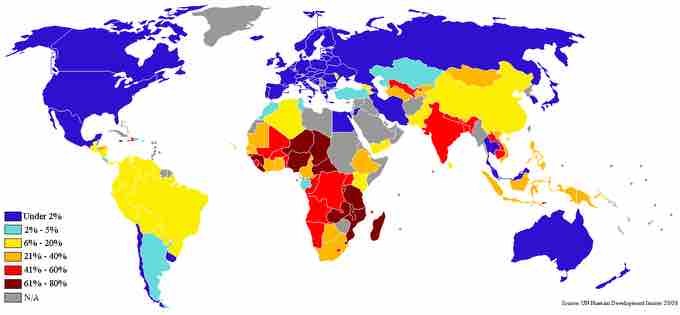Poverty is framed from a material or capital possessions perspective, and is loosely defined as lacking a certain amount to fulfill basic standards of living. Absolute poverty is poverty to the extent of which an individual is deprived of the ability to fulfill basic human needs (i.e. water, shelter, food, education, etc.). The United Nations defines poverty as the inability to obtain choices and opportunities. The existence of poverty is one of the greatest challenges faced by the modern world, both in developing and developed nations (see ). Addressing poverty is best approached through the science of understanding monetary exchanges and the creation of wealth, and thus it is useful to employ an economic perspective when discussing and providing solutions to global poverty.

Percentage of People Living on Less than $1/Day
This map underlines the overall percentage of people in specific countries living on less than one dollar (USD) per day. The important takeaway is the wide range of countries suffering from varying levels of poverty.
The Poverty Line
When conceptually approaching the idea of a poverty line, it is useful to frame it within the context of generating an amount of income that is appropriate to ensure a reasonable standard of living for an individual. Someone below a nationally set poverty line lacks the purchasing power to fulfill their needs and capture opportunities. The United States, for example, has most recently (2012) set the poverty line at $23,050 (annually) with a total of 16% of the population falling under this level (according to the U.S. Census Bureau). Internationally, the World Bank defines extreme poverty as living on less than $1 per day (adjusted for purchasing power).
In observing poverty over time, the rates of poverty alongside the advances in economic production, demonstrates the value in technological and economic progress. The industrial revolution, the modernization (and thus increased efficiency) of agriculture, mass production in factories, technological innovation and a wide range of factors that have driven production and economies upwards have contributed to an increased standard of living. Economically, while the distribution of wealth heavily has tended to benefit the wealthy, there has been great value derived in technological progress in regards to minimizing poverty.
Measuring Poverty
Varying approaches have been developed to measure poverty levels, with a particular focus on creating standardized tools to capture a global context. Poverty is generally divided into absolute or relative poverty, with absolute concepts referring to a standard that is consistent over time and geographic location. An example of absolute poverty is the number of people without access to clean drinking water, or the number of people eating less food than the body requires for survival. Absolute poverty levels, as discussed above, essentially underline the ability for an individual to survive with autonomy. Relative poverty is an approach based more upon a benchmark, that is to say the upper echelon of society versus the poor. Income distribution measures lend insight into relative poverty levels.
One interesting perspective is the Multidimensional Poverty Index (MPI). This index was created in 2010 by the Oxford Poverty & Human Development Initiative alongside the United Nations Development Programme. It leverages a variety of dimensions and applies it to the number of people and the overall intensity across the poor to create a model to capture the extent of the poverty in the region. This dimensions include health, child mortality, nutrition, standard of living, electricity, sanitation, water, shelter (via the floor), cooking fuel and assets owned.